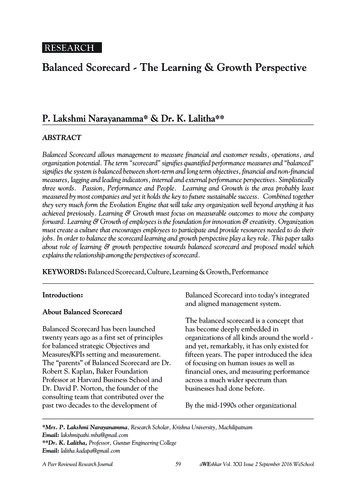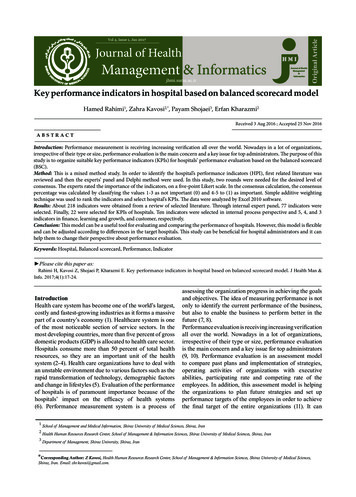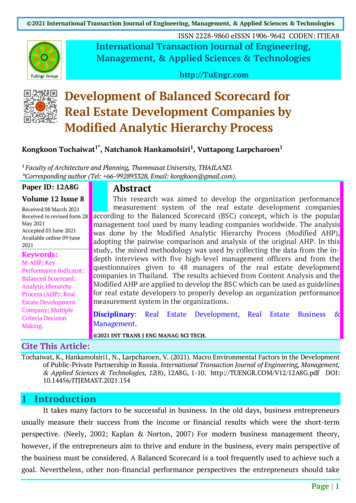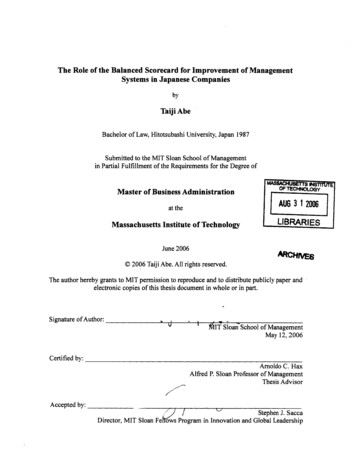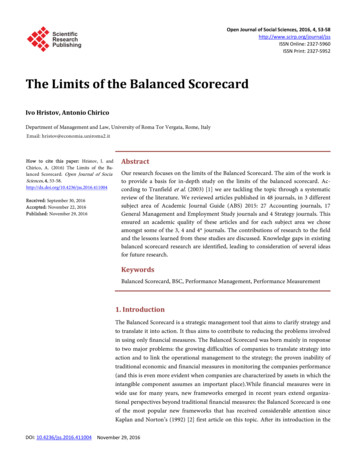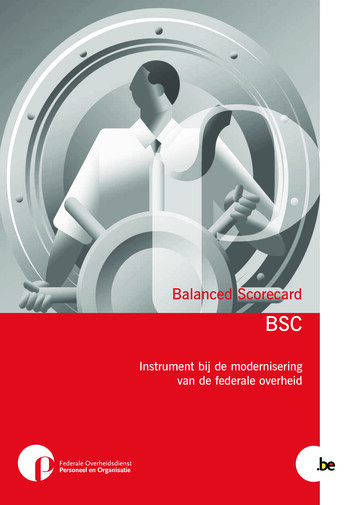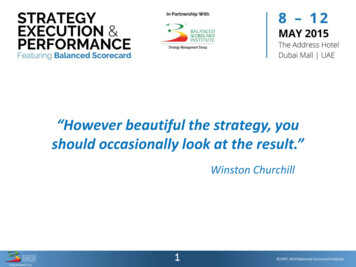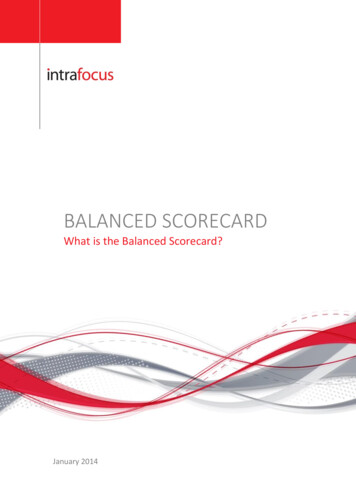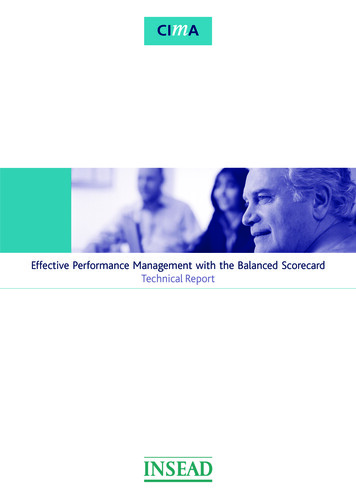
Transcription
Revised: January 2005BALANCED SCORECARDPERFORMANCE MEASUREMENT ANDPERFORMANCE MANAGEMENT PROGRAMFORFEDERAL PROCUREMENTANDMAJOR SITE AND FACILITYMANAGEMENT CONTRACTORPURCHASING SYSTEMS
PREFACEOver the past decade, the Department of Energy (DOE) has reengineered its programs foroversight of Federal and contractor procurement/purchasing systems, replacing Headquartersbased, process-oriented review programs with ones which rely on local assessment ofperformance against Departmental expectations. Through the use of an assessment approach thatfocuses on the accomplishment of results designed to achieve strategic goals, DOE and itscontractor community have fundamentally redesigned performance assessment.From the very beginning of the transition from the traditional purchasing system reviews to theredesigned Federal and contractor system assessment approaches that replaced them, it wasunderstood that further refinement and continuous improvement would occur. Consistent withthat long-term strategy, and building on the originally redesigned Federal and contractorpurchasing assessments, the Department’s business system assessment models evolved to bringthem more formally into line with the Balanced Scorecard (BSC) approach to performancemeasurement and management, which is currently in use by many “world class” privatecorporations.The following describes the Department’s “corporate” business systems assessment program,implementation procedures, evaluation standards, and reporting process as it applies toprocurement systems. This document establishes the Departmental conceptual framework forperformance management for both Federal and contractor purchasing systems assessments, aswell as consistent techniques useful in performing the contract administration and contractoroversight functions. In accordance with these policies and expectations, each Federal andcontractor procurement or purchasing component shall develop a tailored balanced “Scorecard”specific to their individual tactical contribution to Departmental strategic objectives and goals.The core performance measurement approach, strategic objectives, core measures, and nationaltargets outlined in the model program are areas in which the Department intends to achieveconsistency and uniformity, to the greatest extent practicable.Finally, while the program is intended to be a results oriented, systems focused, organizationaccomplished assessment, the Department of Energy Acquisition Regulation (DEAR) stillrequires compliance with specific laws, regulations, and contract terms and conditions. Reviewof compliance procedures is considered an important part of the assessment process as describedin the reporting procedures covered in Parts 6, 7, and 8 of this document.ii
Table of ContentsPage No.Preface .iiTable of Contents .iiiAcronyms .vPART 1: Background .11. Business Systems Performance and Oversight .12. Mission, Vision, and Strategy .13. Business Systems Management Goals .2PART 2: Business Systems Assessment Program .31. Program Objectives .32. Program Concept and Scope .33. Roles and Responsibilities .4PART 3: Performance Management Strategy .71. What is Performance Management? .72. Performance Measures .8PART 4:The Balanced Scorecard Performance Measurement andManagement System.101. The Balanced Scorecard Approach .102. The Four Perspectives of the Balanced Scorecard .10PART 5: Selection of Performance Objectives and Measures .121. Establishing Measures for an Acquisition System .122. The DOE Balanced Scorecard Program .143. Initial Selection, Addition, and Deletion of Performance Measures .17iii
PART 6: Compliance, Operational Awareness, and Reasonable Assurance .191.2.3.4.5.6.7.General .19Quality Assurance .19Risk Assessment .20Compliance Activities .20Peer Review .21Operational Awareness .22Reasonable Assurance .24PART 7: Balanced Scorecard Assessment Plan .251.2.3.4.5.General .25Planning for and Conducting an Assessment .25Problem Analysis and Business System Improvement Action Planning .26Submission of Assessment Plan to HQ . 26Administrative Issues Specific to Compliance .26PART 8: Balanced Scorecard Assessment Report .281. General .282. Data Reporting to DOE Headquarters .293. Administrative Issues Specific to Compliance .30PART 9: Using Performance Measurement Results to Effect Change .311. Performance Measurement Systems Must Provide Intelligence for Decisionmakers,Not Just Compile Data .312. Results Must Be Used or No One Will take Them Seriously .33iv
AcronymsBSCBalanced ScorecardCAPSCenter for Advanced Purchasing StudiesCOContracting OfficerCPSRContractor Purchasing System ReviewDEARDepartment of Energy Acquisition RegulationFASAFederal Acquisition Streamlining ActFARFederal Acquisition RegulationFPDS-NG Federal Procurement Data System – Next GenerationGAOGeneral Accounting OfficeGPRAGovernment Performance and Results ActHCAHead of the Contracting ActivityM&OManagement and OperatingOFPPOffice of Federal Procurement PolicyOMBOffice of Management and BudgetNPRNational Partnership for Reinventing Government (previously known as theNational Performance Review)v
PART 1BackgroundThis part provides a brief discussion of the transition from process-oriented to results-orientedbusiness assessment programs, and of the Department’s goals for assessing business functions.1. Business Systems Performance and OversightThe DOE and its contractors continue to be faced with real and dramatic challenges to improvebusiness systems performance. Federal agencies have been called on to look at commercialmodels for common-sense business solutions and business systems that work better and cost less.Both Federal and contractor organizations are experiencing quantum increases in the levels ofcustomer expectations for qua lity, timeliness, and service -- all at a lower cost. Both Federal andcontractor organizations are facing continuing budget and resource restrictions, which requirefundamentally rethinking approaches to business systems and business relationships.In 1995, the DOE eliminated the “Federal norm” as the standard against which it evaluatescontractor purchasing systems, replacing it with the standards of “best- in-class” purchasingorganizations, be they public or private. At the same time, the Department reengineered itsprograms for oversight of Federal and contractor purchasing systems, replacing Headquartersbased, process-oriented review programs with ones that rely on local assessment of performanceagainst Departmental expectations.2. Mission, Vision, and StrategyThese are the statements of an organization’s highest level purpose, desired end-state, andmethodology for achieving that end-state for its business systems. All objectives and measuresshould support these statements.MISSION: To provide business services to support accomplishment of the Department’sprogrammatic goals and objectives.VISION: To deliver on a timely basis the best value product or service to our customerswhile maintaining the public’s trust and fulfilling public policy objectives.STRATEGY: To develop and maintain an organizational culture, management systems, andline processes in the acquisition system that ensure a focus on results, while emphasizingintegrity, fairness, competition, openness, and efficiency.1
3. Business Systems Management GoalsThe Department seeks to:Ø Translate its vision into clear, measurable outcomes that define successes that will berecognized and shared throughout the Department and with its contractors;Ø Continue to shift from prescriptive, audit-and compliance-based oversight to an ongoing,forward-looking strategic partnership involving Headquarters, the field, and contractors;Ø Provide a tool whereby the overall efficiency, and effectiveness of business systems canbe assessed, managed and improved;Ø Include measures of quality, cost, speed, customer service, and employee alignment,motivation, and skills to provide an in-depth, predictive performance managementsystem; andØ Continue to replace current business systems assessme nt models with an improved andmore consistent approach to performance measurement and management.2
PART 2Business Systems Assessment ProgramThis part describes the objectives, concept and scope of the business systems assessmentprogram. It also addresses the roles and responsibilities of key participants in the program.1. Program ObjectivesThe objectives of the DOE Federal and contractor business systems assessment programs are toensure that business systems adhere to the Department’s missio n, vision and strategy statements;follow recognized “Best Business Management” practices; and comply with applicable statutes,regulations, and contract terms and conditions.2. Program Concept and ScopeThis program requires periodic evaluations of business systems and processes by each intraorganizational component responsible for those systems and processes. This evolutionaryapproach looks beyond compliance and evaluates performance and operational effectiveness.The program is intended to be an adaptable, reliable tool, which moves from transactional toresults-orientation, drives continuous improvement, and which provides for more cost effectiveoversight.The assessment program is characterized by the following key features:Ø It determines the degree of customer satisfaction with performance;Ø It employs measures and trends to determine cost and efficiency of business systems andprocesses;Ø It assesses the organization’s strategic information and skills in order to ensure that theyare aligned to support critical business systems and processes; andØ It ensures compliance with applicable laws, regulations, and contract terms andconditions.This assessment program is consistent with and supports DOE's core values and critical successfactor strategies as listed in the Department's Strategic Plan, in the following areas:Ø Customer Orientation. This approach measures how business decisions and actions areresponsive to the customer's needs.Ø Teamwork. The planning and oversight elements of this program encourage teamwork,particularly integrating and coordinating the roles and responsibilities of DOE HQ,3
Cognizant DOE Offices, and contractors, as appropriate. As part of the team, DOE HQ,Field Offices, and contractors should share pertinent information, as appropriate,regarding field and contractor performance. Cognizant DOE Offices, both in HQ and inthe field, should consider all available data in communicating the Department'sexpectations in assessing performance against such expectations.Ø Best Business Management Practices. Successful business management practicesimprove processes and customer satisfaction, and reduce defects and rework.Although the DOE “corporate” Federal and contractor business systems assessment programencompasses the business functional areas of procurement, personal property, and contractorhuman resources, this document will address the program as it relates to Federal procurementand contractor purchasing. Personal property and contractor human resources will be addressedelsewhere.3. Roles and ResponsibilitiesA. Cognizant DOE OfficeThe Cognizant DOE Office is that entity, either at HQ or in the Field that has the responsibilityfor performing oversight of the Department’s business systems.The Cognizant DOE Office concurs with and validates assessment processes, reviews problemanalyses, and must be knowledgeable about the approach and timing of improvement actionplanning. The outcome of assessments shall be used to determine whether additional “for cause”reviews should be conducted. “For cause” reviews of business system operations may berequired as a result of the identification of significant areas for improvement or trends whichindicate the potential for improvement and require DOE follow- up to protect the Government'sinterest. They may also arise from implementation of new requirements on the contractor or newcontractor systems which require validation.B. Head of the Contracting ActivityThe Head of the Contracting Activity (HCA) may have both operational and oversightresponsibility for DOE business systems. The HCA has operational responsibilities for businesssystems such as the Federal procurement systems, as well as other Federal business systems.The HCA may also have oversight responsibilities for the Department’s major site and facilitymanagement contractors’ business activities.HCAs may consider use of, or tailor, this program to meet system oversight requirements forother contractors where DOE is the Cognizant Federal Agency and the Operations/Field Office isthe Cognizant DOE Office for system oversight purposes. The Cognizant DOE Office willensure that the following requirements are met, when applicable:1). The contractor shall maintain a written description of its business systems which must4
be accepted by the Contracting Officer (CO);2). Substantive changes to a contractor's business systems must be accepted in writing;and3). Periodic self-assessments are performed by the contractor, in accordance with theterms and conditions of the contract and the BSC assessment methodology.HCAs are responsible for the approval, conditional approval, or disapproval of contractors'business systems and for furnishing a copy of system determinations to DOE HQ. HCAs are alsoresponsible for ensuring that Federal contracting activities are complying with applicableacquisition and financial assistance regulations. Part 6 describes the inclusion of compliancereviews as part of the BSC assessment process.C. Cognizant Contracting OfficersThe Cognizant Contracting Officer, for each major site and facility management contractor underhis/her cognizance, shall:Ø Review balanced scorecard development and implementation and ensure conformancewith the program.Ø Evaluate and validate the contractor’s assessment methodology, and monitor thecontractor’s assessment activities.Ø Serve as a peer review participant during assessments and/or as part of verification andvalidation of process and results.Ø Ensure that appropriate steps are planned and carried out to achieve the scorecard’sintended objectives, including ensuring that any additional objectives and measuresidentified by the contractor are consistent with the Department’s objectives and do notserve to sub-optimize the balance of the scorecard.Ø Collect and analyze, as appropriate, contractor assessment results, and advise the HCAand/or the Procurement Executive of any performance issues or compliance deficiencies,as appropriate.Ø Work with the contractor to determine any appropriate actions needed to: 1) identify andaddress management initiatives by DOE or the contractor needed to assist achievement ofstrategic objectives/targets; 2) identify and implement additional or revised objectivesand initiatives; and 3) identify benchmarking and process improvement opportunities tofacilitate leveraging knowledge across the DOE complex.5
D. ContractorEach applicable contractor is responsible for establishing and maintaining business systems andprocesses which meet Departmental requirements. Contractors are also responsible forconducting credible, documented assessments of the business processes, to include problemanalyses and improvement planning to ensure compliance with applicable laws, regulations, andterms and conditions of the contract. Compliance should focus on objectively measurablecriteria and allow for meaningful trend and rate of change analyses. If requested by thecontractor, outside entities may aid in administering the contractor's assessment program.E. Director, Office of Procurement and Assistance Management (The ProcurementExecutive)When requested by the HCA, the Procurement Executive will provide consultation, training, orfacilitator services to Cognizant DOE Offices or contractors based on availability of resources,including facilitation of benchmarking and process improvement based on BSC results.DOE Operations/Field Office performance will be evaluated as part of the Federal BalancedScorecard Performance Management Program. Under that program, DOE Operations/FieldOffices will perform assessments of the Federal procurement systems as well as managecontractor oversight.Cognizant DOE Office implementation of the contractor BSC program will be evaluated as partof the Federal BSC assessment program administered by DOE HQ.6
PART 3Performance Management StrategyThis part sets forth the definitional baselines for performance measurement and performancemanagement, provides a discussion of the characteristics and types of measures, and discussesDepartmental and local targets for performance.1. What is Performance Management?There are a wide range of definitions for performance objective, performance goal, performancemeasure, performance measurement, and performance management. To frame the dialog and tomove forward with a common baseline, certain key concepts need to be clearly defined andunderstood, such as:Ø Performance objective. This is a critical success factor in achieving the organization’smission, vision, and strategy, which if not achieved would likely result in a significantdecrease in customer satisfaction, system performance, employee satisfaction orretention, or effective financial management.Ø Performance target or goal. A target level of activity expressed as a tangible measure,against which actual achievement can be compared.Ø Performance measure. A quantitative or qualitative characterization of performance.Ø Performance measurement. A process of assessing progress toward achievingpredetermined goals, including information on the efficiency with which resources aretransformed into goods and services (outputs), the quality of those outputs (how well theyare delivered to clients and the extent to which clients are satisfied) and outcomes (theresults of a program activity compared to its intended purpose), and the effectiveness ofgovernment operations in terms of their specific contributions to program objectives.Ø Performance management. The use of performance measurement information to effectpositive change in organizational culture, systems and processes, by helping to setagreed-upon performance goals, allocating and prioritizing resources, informingmanagers to either confirm or change current policy or program directions to meet thosegoals, and sharing results of performance in pursuing those goals.Ø Output measure. A calculation or recording of activity or effort that can be expressed ina quantitative or qualitative manner.Ø Outcome measure. An assessment of the results of a program compared to its intendedpurpose.7
2. Performance MeasuresEach performance objective should be supported by at least one measure that will indicate anorganization’s performance against that objective. Measures should be precisely defined,including the population to be measured, the method of measurement, the data source, and thetime period for the measurement. Measures should be written as mathematical formulae,wherever possible.A. Characteristics of MeasuresIdeally, measures should possess the following characteristics:Ø Objective - not judgment calls.Ø Controllable - the results are substantially in the hands of the organization with theeffects of potential outside influences minimized.Ø Simple - easily understood and measuring only one thing.Ø Timely - frequently available indicators of recent or current performance.Ø Accurate - reliable, precise, sensitive indicators of results.Ø Graded - trackable data available before system failure-not binary yes/no measures.Ø Cost-effective - providing data worth the cost of gathering it.Ø Useful - providing data necessary for the organization to manage the business.Ø Motivating - achieving the targets should drive good business decisions-not overexpenditure, over compliance, or other sub-optimization.B. Types of MeasuresTypes of measures normally include the following:Ø Core Measures. These are measures the Department expects all elements to employwhere applicable. The formulae and methods for core measures shall be maintained asstandard as is practicable from site to site.Ø Optional Measures. These are measures suggested, but not required, by the Department,and may be useful indicators for assessing progress towards the predetermined coreobjective.Ø Local Measures. These are measures, which have site or contractor specificity, that each8
site may identify and include as part of their BSC.Ø Outcome and In-Process Measures. Core, optional, and local measures may be outcomeor in-process measures. All are indicators of performance (mission success in businesssystems). Outcome measures may be found in the Customer, Financial or InternalBusiness Process Perspectives. Outcomes are products delivered to customers. Outcomemeasures establish the current performance of a system.In-process measures will drive future performance, and are no less important thanoutcome measures. However, success is only desirable in these metrics, to the extent thatit leads to success in outcome measures. Success in these measures alone will not satisfycustomers. Poor performance in these measures may be addressed in time to preventnegative impact on process outcomes and customer satisfaction. In short, in-processmeasures are management tools to drive and sustain performance.C. Departmental Expectations/National TargetsThe Department has established Departmental expectations (desirable scores) for its coremeasures. These expectations or targets correlate to performance levels demonstrated bysuccessful organizations. All sites shall strive to meet or exceed these expectations/targets. It isrecognized that local situations are impacted by organizational alignment, structure, vision,strategic objectives, and current conditions.D. Local TargetsEach site may establish short-term local targets for core, optional and local measures. Whilethese should provide aggressive “stretch” performance targets, they should be realistic. There islittle benefit in creating unrealistic or unattainable targets for “optics.” It is expected that whentargets are set below Departmental expectations, they will be set to stimulate substantial progresstoward those expectations and will rise over time. Similarly, where organizations have alreadyexceeded Departmental expectations, targets in excess of National averages may be maintainedas part of continuous improvement.It is understood that performance should not be driven beyond what is necessary to be supportiveof the organizational mission, taking into consideration funding and resource realities (e.g.,though it is always desirable to drive cost-effectiveness, it is recognized there is a point inperformance or cycle time beyond which improvement does no service to the customer and coulddrive unnecessary costs.) Local targets may therefore not rise perpetually. When acceptablelevels are achieved, these should be maintained and other performance areas emphasized whoseimprovement have greater strategic importance.9
PART 4The Balanced Scorecard Performance Measurementand Management SystemIn this part, the framework of the Balanced Scorecard performance measurement andmanagement system is discussed, including a description of the four perspectives of theassessment methodology.1. The Balanced Scorecard ApproachThe BSC is a performance measurement and performance management system developed byRobert Kaplan and David Norton (see “The Balanced Scorecard--Measures That DrivePerformance,” Harvard Business Review, Jan-Feb 1992; and “The Balanced ScorecardTranslating Strategy into Action,” Harvard Business School Press, 1996) and has been adoptedby a wide range of leading edge organizations, both public and private.The BSC is a conceptual framework for translating an organization’s vision into a set ofperformance indicators distributed among four perspectives: Financial, Customer, InternalBusiness Processes, and Learning and Growth. Indicators are maintained to measure anorganization's progress toward achieving its vision; other indicators are maintained to measurethe long term drivers of success. Through the BSC, an organization monitors both its currentperformance (finances, customer satisfaction, and business process results) and its efforts toimprove processes, motivate and educate employees, and enhance information systems--itsability to learn and improve.2. The Four Perspectives of the Balanced ScorecardA. FinancialIn government, and with DOE’s major site and facility management contractors, the “financial”perspective differs from that of the traditional private sector. Private sector financial objectivesgenerally represent clear long-range targets for profit-seeking organizations, operating in apurely commercial environment. Financial considerations for public organizations, to includethe DOE’s major contractors, have an enabling or a constraining role, but will rarely be theprimary objective for business systems. Success for such organizations should be measured byhow effectively and efficiently these organizations meet the needs of their constitue ncies. Ingovernment, and for DOE’s contractors, this perspective captures cost efficiency, deliveringmaximum value to the customer for each dollar spent.10
B. CustomerThis perspective captures the ability of the organization to provide quality goods and services,effective delivery, and overall customer satisfaction. For purposes of this model, both therecipient of goods and services (the internal customer) and the sponsor/overseer (DOE) areregarded as customers of the business processes. In a governmental model, or for DOEcontractors, the principal driver of performance is different than in the strictly commercialenvironment; namely, customers and stakeholders take preeminence over financial results.Recognizing that budgets are limiting factors, public organizations and DOE contractors have agreater stewardship responsibility and focus than do private sector entities.C. Internal Business ProcessesThis perspective provides data regarding the internal business results against measures tha t leadto financial success and satisfied customers. To meet the organizational objectives andcustomers’ expectations, organizations must identify the key business processes at which theymust excel. Key processes are monitored to ensure that outcomes are satisfactory. Internalbusiness processes are the mechanisms through which performance expectations are achieved.D. Learning and GrowthThis perspective captures the ability of employees, informatio
v Acronyms BSC Balanced Scorecard CAPS Center for Advanced Purchasing Studies CO Contracting Officer CPSR Contractor Purchasing System Review DEAR Department of Energy Acquisition Regulation FASA Federal Acquisition Streamlining Act FAR Federal Acquisition Regulation FPDS-NG Federal Procurement Data System - Next Generation GAO General Accounting Office
